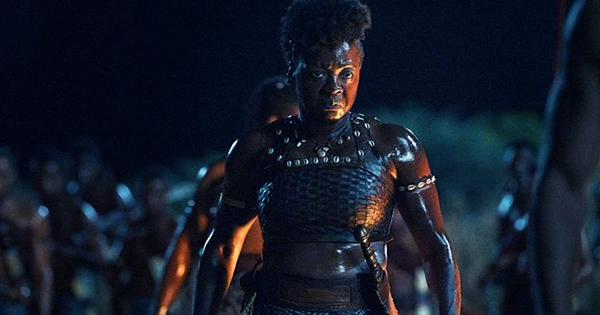Incredible shots from The Woman King reveal a strong Viola Davis in the lead role of a film that has already become a box office smash with a $19 million+ opening weekend. The Agojie, an all-female regiment of warriors who guarded the African Kingdom of Dahomey in the 1800s, is fictionalized in the movie, but even so, it’s already proving to be a worthy tribute to a legendary and formidable fighting force.
The history of the Kingdom of Dahomey spans 300 years, from 1600 to 1904. From 1818 until 1858, King Ghezo (or Gezo), who succeeded his brother Adandozan in a coup d’état, governed this part of west Africa, in what is now the Republic of Benin. The fearless and shrewdly all-female Agojie, who were referred to by Europeans as the “Amazons” of Dahomey, guarded Ghezo during his rule.
The word “Amazons” has been used in the past to refer to warrior women from all over the world. It is frequently associated with behaviors like reproducing with males to increase the number of women in an army, occasionally castrating or killing any male progeny as a result. According to The “Amazons” of Dahomey author Robin Law, these beliefs were probably exaggerations, which may have better captured historical male apprehension over possible female authority.
Although there is evidence of a female force existing in the kingdom prior to his appointment, King Ghezo, who appears in The Woman King, is sometimes credited with the founding of the Agojie. Whatever their ancestry, the Agojie had evolved throughout Ghezo’s rule from hunters to a valiant army that fought to the death to defend their throne.
According to Mike Dash for Smithsonian magazine, the honor allowed them to entrance to the royal grounds after dark, something Dahomey’s men were not allowed to do. They were given access to slaves, beer, and tobacco here, and they were free to move around the grounds with a bell ringer telling the Dahomey men to move out of their way.
Male and female counterparts were frequently given roles in the Kingdom of Dahomey, Agojie scholar and historical consultant Professor Leonard Wantchekon told the Guardian. “Dahomey’s social conventions were quite gendered inclusive, which is something really special. Girls played alongside boys and participated in all of the traditional activities, like farming and commerce, that guys do. A strong sense of fair gender norms and women’s representation in government has long existed.
Beyond Dahomey, the Agojie was the best-known exemplar of “Amazons” in pre-colonial Africa, and they have since served as an inspiration for movies like Ryan Coogler’s Black Panther and The Woman King, which both show women in prominent roles in society as queens, mothers, council members, and warriors.
In fact, as the Palace of Dahomey developed, Agojie women’s multifarious roles expanded, according to architectural historian Lynn Ellsworth Larsen, who wrote the chapter Wives and Warriors in The Routledge Companion to Black Women’s Cultural Histories (2021). She discovered that it is difficult to understand the gender dynamics in the Kingdom of Dahomey.
The King may have thousands of wives residing inside the palace walls when the Agojie were originally enlisted, and it is believed that they were later recruited from captives. Being legally married to the king meant that they were effectively celibate if they weren’t with him, which would seem to be contrary evidence to the Amazons’ alleged propensity for having children and killing them (a lifestyle that, according to Amélie Degbelo, author of Les Amazones du Dahomey [1645– 1900], as cited by Law, was sometimes encouraged by the practice of clitoridectomy).
The question remains: Were the historical royal women of Dahomey advocates or even accomplices of a patriarchal system despite their significant political and spiritual influence? Larsen put forward that the Agojie continued to exist up until the patriarchal rule of a king to whom they were subject. On the other hand, the monarch shared the throne with his kpodjito, or reign partner, who, despite not being as visible, is said to have had an equal impact on Dahomey society. As Larsen correctly noted, “We must also be mindful of imposing a western, contemporary form of feminism on another culture, period, and place in our assumptions about Dahomey’s women.”
Even though there were other female fighters in existence throughout Ghezo’s reign besides the Agojie, some consider them to be the only ones that engaged in such extensive fighting and defense, often at the cost of thousands of lives. Ghezo’s violent overthrow of his brother may help to explain why he desired a small group of devoted soldiers, as he was said to have feared unrest and betrayal among his subjects.
As evidenced by Captain Duncan of the Life Guards, the senior regiment of the British Army, who stated, “appearance is more martial than that of the men, on a campaign I would prefer the women of that country as soldiers to the men,” over time, the Agojie came to be more feared (among Europeans, at least) than their male counterparts. I believe the King of Dahomey has a stronger army than any other west of the Great Sahara based on everything I have observed in Africa.
According to Law, the Agojie were praised as having greater aim because they shot their muskets from their shoulders rather than their waists, unlike the men, and because they could reload and discharge their weapon in under 30 seconds compared to the 50 that it took their counterparts. Nevertheless, even the Agojie themselves maintained the idea that fighting was associated with masculinity, despite their superiority over men in combat.
According to Law, the former Amazon Tata Aj aja reported hearing the words “You are a man” after murdering and dismembering her first foe in a report from the 1920s. It reportedly went as far as to view frailty as a characteristic of women, as evidenced by the lyrics they sung in celebration of their triumph over Atakpame:
We marched against the Atahpahms as against men,
We came and found them women.
After arduous training that taught them how to fight, how to kill without hesitation, survival techniques, and pain tolerance, they made the transition from enrollee to warrior. Their methods of execution included decapitation and dismemberment, with the heads of their victims occasionally being kept as souvenirs.
Their ferocity and effectiveness earned them acclaim as elite warriors from a great distance away, but it would all come to an end when the Kingdom of Dahomey came into the eyes of European explorers rushing to reach Africa. It was a place of special appeal with access to numerous coastal towns, and despite France making multiple agreements to designate some areas as French protectorates, discussions soon turned sour.
Eventually, under the direction of General Alfred-Amédée Dodds, the French staged a military coup in 1892, and the Agojie supposedly fell in November of that year.
While the ferocity of the Agojie is what people most associate them with, as seen in the dramatic trailer for The Woman King, American director Gina Prince-Bythewood aspires to portray these ladies in all of their nuance. They should be honored for all that they underwent and survived because they were women who had empowerment via their skill and standing but also experienced loss of life and agency as a result of those same characteristics.
According to Prince-Bythewood, “We didn’t want to represent them as just one thing – badass ladies who killed.” They also cried, loved, and laughed. Not just the cool component that would look good in a trailer, but their whole humanity was something we wanted to express.














